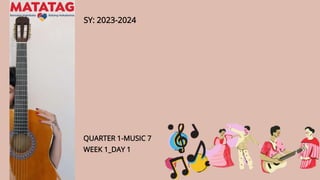Q1 PPT_MUSIC 7_Wk1 (Folk Songs from Lowlands of Luzon).pptx
- 1. QUARTER 1-MUSIC 7 WEEK 1_DAY 1 SY: 2023-2024
- 2. 1.identifies the musical characteristics of representative music selections from the lowlands of Luzon after listening. (MU7LU-Ia-1) 2.analyzes the musical elements of some lowland vocal music selections (MU7-LU-1a-2) 3.sings folksongs from the lowlands of Luzon (MU7LU-Ia-h7)
- 7. 1 The lyrics are according to the native tongue. 2 Passed down through oral tradition to family or community members, hence, learned by mere memorization 3 Unknown composers and lyricists 4 Simple key signature of the song 5 Duple, triple, or, quadruple are common meters used 6 Primarily based on the communityŌĆÖs culture, tradition and livelihood 7 Short and Simple
- 8. Because songs are based on the daily experiences of the people in a particular place and the message of the songs needs to be understood easily to be appreciated, the lyrics of the songs are written or sung in their own dialects. For example, the Tagalog folk songs came from the people who speak Tagalog. (Bahay Kubo, Leron, Leron Sinta, Magtanim ay ŌĆ×Di Biro). The Ilocanos have their own (Manang Biday and Pamulinawen). The KapampanganŌĆÖs Atin Cu Pung Singsing, and the BicolanoŌĆÖs Sarung Banggi are just a few among the folk songs of Luzon that are sung in their own dialects.
- 9. Singing is a form of social bonding among early Filipino families. Because they did not have access to internet, T.V. and radio during that time, singing folksongs became their favorite pastime.
- 20. ASSESSMENT
- 21. 1. Luzon lowland folksongs have a very distinctive Spanish influence. 2. Folksongs are generally taught in schools. 3. Sitsiritsit is a Tagalog folksong. 4. An example of a Kapampangan folk song is Sarung Banggi. 5. The composers and lyricists of folk songs are usually unknown. 6. Naraniag a Bulan is an example of an Ilocano folk song. 7. Folk songs are mostly short and complicated. 8. Key signatures in folk songs do not change. 9. Folk songs are based on the community's livelihood, tradition and culture. 10. Atin Cu Pung Singsing is an example of a Bicolano folk song.





















